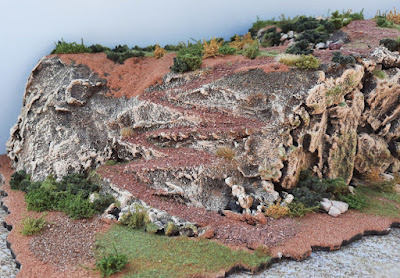Another addition to my 15mm Biblical town, this time inspired by the above Bible verse.
The
temple is based on the Philistine temple excavated at Tell Quasile, near Tel
Aviv.
As
always built on a Sarissa Precision Terrain Tile, this time 300mm square.
Built
from MDF, with assorted bits of dowel and pine strip. Textured with chinchilla
sand and painted with Mylands Marble Matt emulsion paint. Window frames are
dice frames from Pendraken/Minibits, doors from Cedar of Lebanon. (Of course!)
As always,
the dirt and sand on the base is from Israel.
Inside
we have the Ark and Dagon himself. Details of the Ark below, the Dagon idol is scratchbuilt
from green stuff on a brass wire armature.
Next
a Forged in Battle priest offering a Baueda boar as a sacrifice.
The kitchen, also Baueda with a Donnington cook preparing
the last sacrifice for the congregation. Note the Blue Rock Thrush in the
pomegranate tree. He is a 3d resin print from Infernal Prints on eBay. The tree
is scratchbuilt.
The neighbouring shrine of Ishtar. Crom’s Anvil firebowl either
as a beacon, or to allow me to take the roof off!
Priestess from Mick Yarrow Miniatures, idol scratchbuilt
like her consort.
Finally, the somewhat obsessive bit: the Ark of the Covenant.
Made, as instructed, from Shittim wood. (It has taken me over twenty years to
find some!) Cherubim are N gauge model rail cats with cigarette paper wings.
All gold leafed, with a bit of paint to fill the missed bits and tone it down a
little.
And, of course, the contents of the Ark. The Tablets of the
Law, made according to tradition from lapis lazuli, and rectangular rather than
round-topped. A jar of manna from the time the tribes were wandering in the
desert (Essex Miniatures) and Aaron’s rod, made, as it should be, from Almond
wood. (Courtesy of a guitar plectrum.)



















































